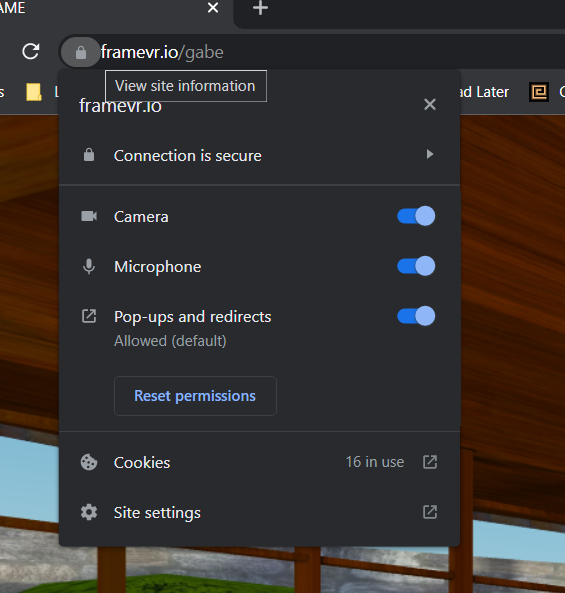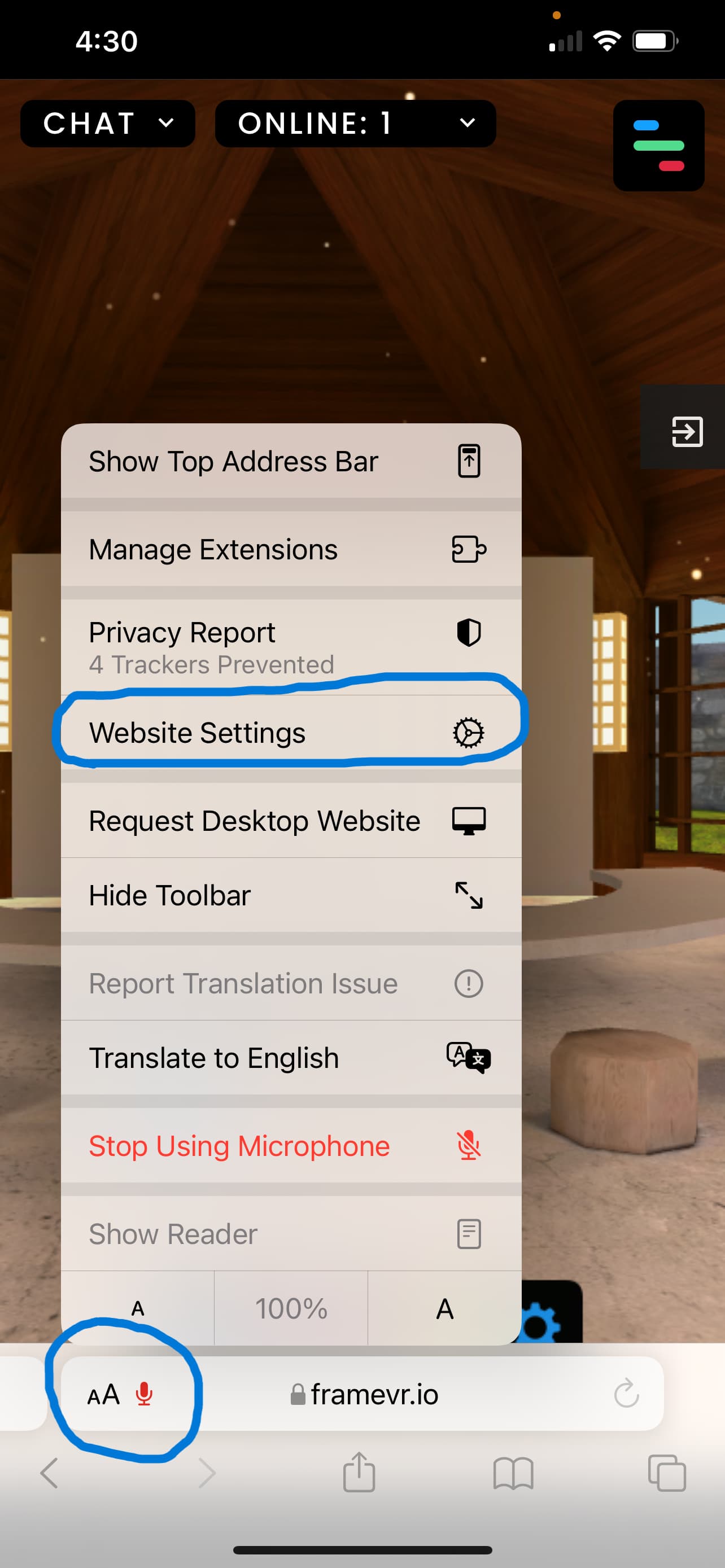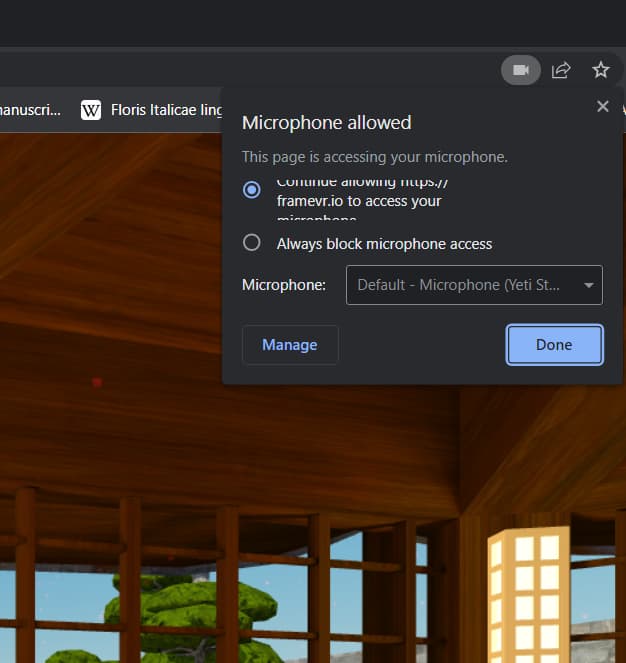Troubleshooting Frame
At Frame, we try to make the metaverse easy.
For many people, connecting to Frame "just works", but it's a delicate dance of technologies that makes this happen. There's a lot that can go wrong along the way depending on your hardware, internet, and browser. This post will give a basic troubleshooting guide to help you through some of the common issues and things to watch out for. I'll go through things in the order we typically go through when we're troubleshooting.
These are things to try when things aren't working as you expect!
1. Browser
First, it's a good idea to make sure that you're using the right web browser.
We recommend Chrome or Edge for every device besides VR Headsets or iOS devices likes iPhones and iPads.
On the Oculus Quest, use the "Browser" app on the device.
For iOS devices, we recommend Safari. This isn't to say that other browsers like Firefox or Opera won't work, but the most reliable web browsers for most devices are the latest Chrome or Edge.
Update your browser to ensure it is on the latest version.
1.5 Enable Hardware Acceleration
While this is often on by default when you install a web browser, you want to make sure that "hardware acceleration" is enabled in your browser settings.
Chrome, go to your browser settings with the button at the top right of the browser (it looks like three small dots). Find the "advanced" section in the sidebar on the left, then "system". In the list of settings shown, you will see hardware acceleration. Make sure it is enabled. In Edge, go to browser settings, then system and performance - you will find hardware acceleration there. In Safari, if you have to use that browser, hardware acceleration is always on.
2. Browser Permissions
You have to make sure that your browser has permission to use your microphone and camera, if you hope to use your microphone or webcam. Note - these aren't required for access to Frame, but if audio or video isn't working for you, you should check your browser permissions.
On your web browser, navigate to your Frame. Then, click the icon to the left of the URL in the address bar to check the permissions that are granted to the page. You want mic and camera to be on.

On iOS devices, you want to pull up the URL bar and also click the icon to the left of the URL. Then, click on website settings to make sure that the browser has permissions to access your microphone and/or camera.

On the Oculus Browser, navigate to your Frame, and before entering VR mode you should open the browser settings with the icon at the top right. It looks like three dots. From that menu, you can check the site permissions and ensure that microphone permission is on.
3. The Right Microphone/Camera
Now that you've got the right browser and permissions (hopefully), your audio still might not be working if your browser is trying to access a microphone that is different from the one you're trying to use. Different devices handle multiple audio devices differently, but we do give you a way in Frame to make sure you have the right microphone and camera devices selected. When you go to your Frame, before clicking Connect look below the Connect button and check out the "MIC/CAM SETTINGS" button. This will let you pick the right device for your microphone and camera.
You can also change the microphone device within Frame itself by right clicking on the mic icon near the bottom center of the screen.
It can be annoying to do this each time, though. To make sure your browser picks the right devices by default, you can go into your browser settings. On Chrome, you will see a button at the far right of the URL bar that looks like a little video camera. On Edge, the button looks like a microphone. Click that, and if you see the wrong device selected there, click on the "Manage" button to open up the relevant browser settings. There, you can change the default device that your browser will try to access.

4. Browser Extensions/Ad Blockers
One thing you want to check is whether you have any browser extensions, add-ons, or ad-blockers that might be interfering with Frame. To check if this is the case, try to open Frame in an incognito browser window, or disable all of your extensions, and see if Frame works then. If it does work with extensions disabled or in an incognito tab, this might be the culprit. We'd love to debug that with you, so email support@framevr.io with a list of your browser extensions and we can try to see which one might be interfering with Frame.
One strange thing we've noticed is that the Grammarly browser plugin doesn't play nice with Frame. You should disable it before trying to use Frame.
5.Wifi Network
If you're on an office or school wifi network, it might have restrictive permissions or firewalls in place that make connecting to Frame difficult. We do have some measures in place that allow tunneling through basic firewalls, but this won't always work for all networks.
One thing to do to check if this might be a wifi/network issue is to do this network test. If you see some things "fail" on this test, then the issue might be your particular network. You can email us at support@framevr.io with your results if you want us to help you get to the bottom of it. Also, if you are able to tweak your network settings to make sure Frame will run on your network, check out this document.
6. Odds and Ends
This isn't so much a connectivity issue, but just in case Frame is a bit laggy for you, you want to make sure that "Hardware Acceleration is Enabled" in your browser system settings. Go to your browser settings and look for "System" or "System & Performance" and look for that setting. We also recommend not having hundreds of browser tabs open while you're using Frame.
If you're still having issues after going through all of the above steps, please let us know and provide any details you can to support@framevr.io
.png)

.jpg)